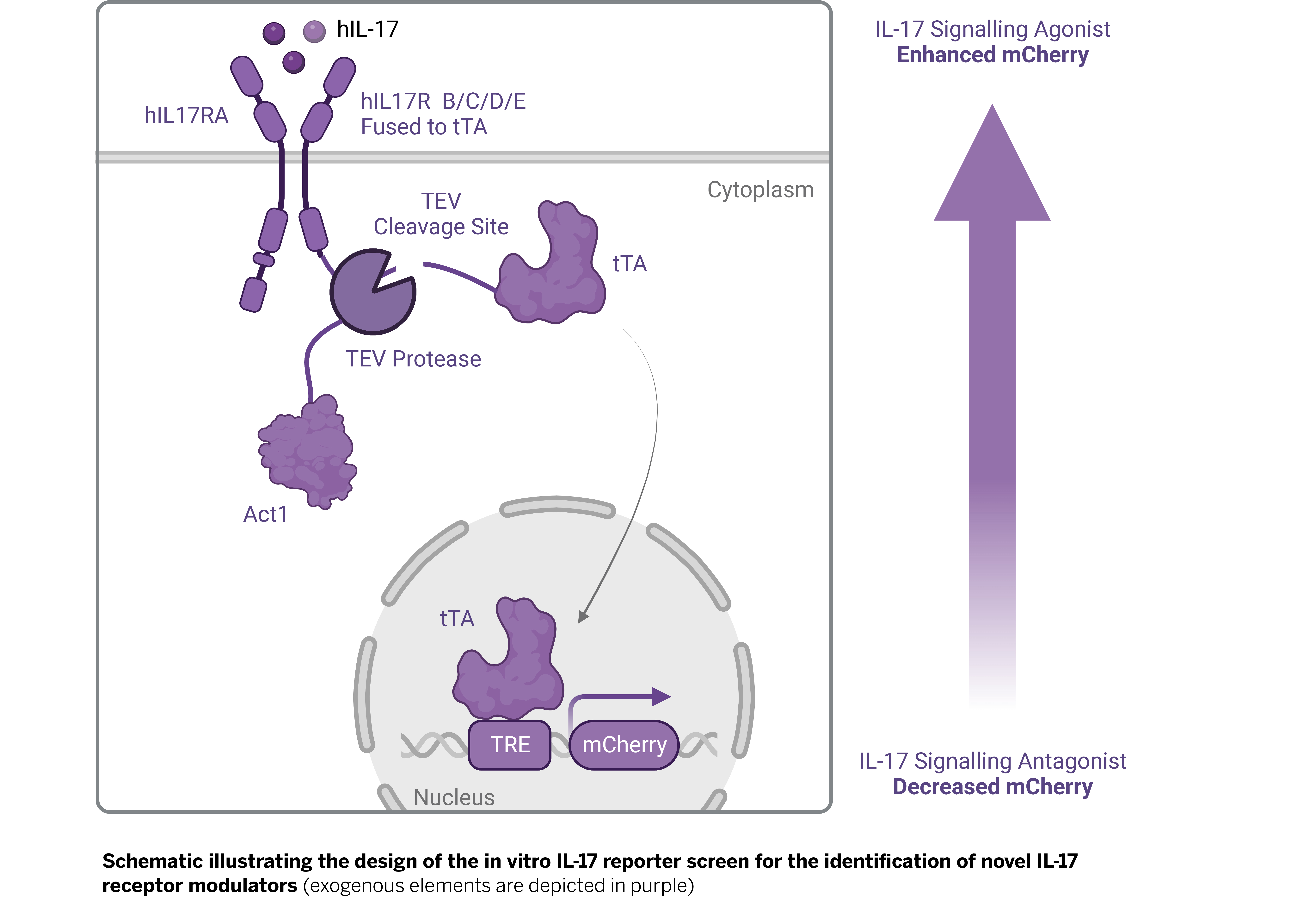IL-17 Receptor Modulator Screen

Unmet Need
Innovative, versatile and scalable reporter system for the identification of novel IL-17 receptor modulators for IL-17 signaling functions.
Technology
The Littman Lab has developed and validated an in vitro assay for the quantification of Act1-dependent IL-17 signaling, utilizing specific fusion proteins and a fluorescent reporter readout. The assay is an in vitro protein-protein-interaction (PPI) based reporter consisting of three key components: 1) a modified IL-17 receptor subunit fused intracellularly to the transcriptional transactivator (tTA) with peptide linker recognizable as the cleavable site of a tobacco etch virus (TEV) protease; 2) the integral IL-17 signaling adaptor protein Act1 fused to TEV protease; and 3) a mCherry fluorescent reporter under the control of a TRE-CMV promoter. In the presence of an IL-17 cytokine or an IL-17 receptor agonist, subunits of the IL-17 receptor assemble leading to the recruitment of TEV-fused Act1, which in turn, cleaves the TEV-cleavable site (TCS) on the modified IL-17 receptor, and causes the subsequent release of tTA to the nucleus which drives mCherry expression and the fluorescence signal in the cell (See schematic). The inventors have modified two sets of human IL-17 receptor family subunit pairs (IL-17RA with IL-17RC as cognate receptors for IL-17A/F, and IL-17RA with IL-17RB as cognate receptors for IL-17E, also known as IL-25) enabling this reporter system to measure activity of the most prominent IL-17 cytokine family signaling pathways and identify new modulators (agonists and antagonists) of such pathways.
Background
The IL-17 family of cytokines play a critical role in innate and adaptive immune responses. However, dysregulated IL-17 signaling has been implicated in the pathogenesis of various autoimmune and inflammatory diseases as well as chronic infections. Current therapeutic strategies for IL-17-mediated diseases leverage biologics (neutralizing antibodies) blocking IL-17 signaling. Yet, these therapeutics are expensive, challenging for scaling up, and not easily administered as oral therapeutics. Small-molecule modulators targeting the IL-17 signaling pathway (ligand and cognate receptors) are a promising alternative avenue for therapeutic exploration and development of not only antagonists but also agonists for IL-17 cytokine family signaling. Moreover, tissue-specific expression of receptor complexes responding to the same cytokine (e.g. IL-17A signals through both IL-17RA/RC and IL-17RA/RD) offers potential for more targeted therapies. The technology described herein offers an innovative, versatile and scalable means to effectively address this unmet need and identify novel modulators of IL-17 signaling.
Applications
- Screening for new therapeutics: Identification of IL-17 signaling activators or inhibitors (small molecules and/or biologics) for potential use as treatments for autoimmune and inflammatory diseases, including:
- rheumatoid arthritis
- psoriasis
- atopic dermatitis
- inflammatory bowel disease
- Investigating IL-17 signaling functions in preclinical models: Interrogation of downstream signaling pathways in diverse organs and cell types, including tumors and their microenvironment, regulated by IL-17 in the context of basic and translational research.
Advantages
- Established approach: The underlying screening technology has been used successfully to identify G-protein-coupled receptor modulators.
- Scalable: The reporter system can be used for single compound testing and high-throughput screening of large chemical libraries.
- Dual readout: IL-17 signaling pathway agonists and antagonists can be identified.
- Versatile: The screen could be implemented across cell types/disease contexts and with different modified IL-17 receptor isoforms.
Intellectual Property
NYU has filed a provisional patent application covering composition and method of use.
Future Development
The inventors plan to expand the technology to modify more sets of IL-17 receptor family subunit pairs for Act-1 dependent signaling pathways.